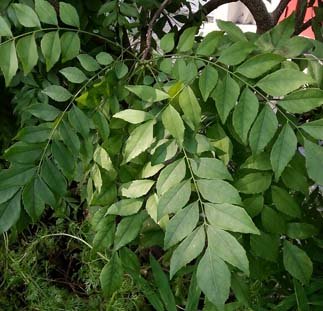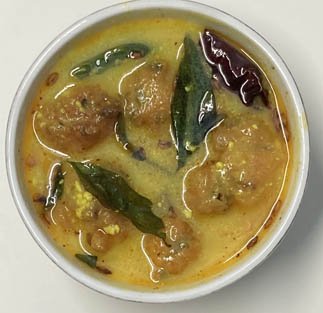Curry leaf Nutrition facts
Curry leaf is a peppery-flavored, aromatic leaf obtained from a small, tropical tree in the Rutaceae family, native to the Indian Subcontinent.
Curry leaves are used extensively as a spice to flavor dishes which makes food both healthy and tasty.
Scientific name: Murraya koenigii.
 |
| Curry leaf plant Photo courtesy: Jnzl's Photos |
India is the largest producer and consumer of curry leaves. The Southern state of Tamil Nadu is the largest producer of curry leaves. The spice is also used extensively in Burma, Malaysia, and South Africa, where a large Indian Diaspora exists.
Curry leaf thrives well in tropical and semi-tropical climates. Red sandy loam soil with good drainage is ideal for better yield. The optimum temperature requirement is 26-37 ° C.
Curry leaf plant is propagated through seeds. 1-year-old seedlings are suitable for planting.
For raising seedlings, well ripe fruits are collected from high-yielding plants. At the end of the first year, 250-400 kg of leaves/ha can be harvested.
Health benefits of curry leaf
Curry leaf, used as a spice in cooking, contains many notable plant-derived compounds, minerals, and vitamins that are essential for optimum health.
Important chemical compounds found in curry leaves are ß-caryophyllene, ß-elemene, ß-thujene a-selinene, ß-bisabolene, limonene, ß-trans-ocimene, and ß-cadinene. These phytochemical compounds possess important health-benefiting properties.
Fresh leaves are moderate in energy, carrying 97 calories/100g. The leaves also contain ample amounts of soluble and insoluble fiber, which helps in the reduction of serum LDL cholesterol levels as well as in smooth bowel movements.
Its fresh leaves and herb parts are very rich in folates. Contains about 94 μg (23.5% of RDA) per 100 g. Folates are important in DNA synthesis and when given during the peri-conception period can help prevent neural tube defects in the baby.
Curry leaves are an excellent source of vitamin A; contain 3767 IU or 125% of recommended daily levels per 100 g.
Vitamin A is a natural antioxidant and is an essential vitamin for vision. It is also required for maintaining healthy mucosa, hair, and skin. Consumption of natural foods rich in vitamin A has also been found to help protect from lung and oral cavity cancers.
The spice leaf is indeed a very good source of many vitamins such as thiamin, niacin, pyridoxine, pantothenic acid, and riboflavin. These B-complex groups of vitamins help in enzyme synthesis, nervous system function, and regulating body metabolism.
Curry leaf also contains a good amount of minerals like calcium, copper, iron, potassium, magnesium, manganese, zinc, and selenium.
Medicinal uses of bay leaf
Curry leaf's natural flavoring agents possess various antioxidant properties and have the ability to control diarrhea, indigestion, and peptic ulcers.
They are also believed to have cancer-fighting and liver-protecting properties.
In Ayurvedic medicine, curry leaves are supposed to cure diabetes and help maintain a healthy cholesterol balance.
Skin Care: Curry leaves extraction or paste may be applied to burns, bruises, and insect bites for quick healing.
Hair Care: Curry leaves are also helpful in hair care and are believed to help in dandruff clearance and strengthening hair roots. Dry curry leaf powder mixed with oil can be applied to your hair on a regular basis to improve hair growth as well.
| Principle | Nutrient Value | Percent of RDA |
|---|---|---|
| Energy | 97 Kcal | 5% |
| Carbohydrates | 13.3 g | 10% |
| Protein | 7.9 g | 14% |
| Total Fat | 1.3 g | 6.5% |
| Cholesterol | 0 mg | 0% |
| Vitamins | ||
| Folates | 94 μg | 23.5% |
| Niacin | 2.3 mg | 14% |
| Riboflavin | 0.21 mg | 16% |
| Thiamin | 0.08 mg | 7% |
| Vitamin-A | 1130 μg Retinol eq | 125% |
| Vitamin C | 8 mg | 9% |
| Electrolytes | ||
| Sodium | - | - |
| Potassium | - | - |
| Minerals | ||
| Calcium | 820 mg | 82% |
| Copper | 0.21 mg | 23% |
| Iron | 5.10 mg | 64% |
| Magnesium | 220 mg | 55% |
| Manganese | - | - |
| Phosphorus | 57 mg | 8% |
| Selenium | - | - |
| Zinc | - | - |
Selection
Fresh curry leaves are easily available in the farmer markets in South Indian States, Sri Lanka, and the Maldives. Since curry leaves lose their delicate fragrance soon after drying, you should try to obtain them fresh.
Choose fresh, bright green, and crisp leaves tied in loose bundles. Avoid dry, wilted, and discolored leaves.
Storage
Curry leaves do not store well and are always used fresh for flavor. Sometimes, fresh leaves are deep-fried in oil and stored in an air-sealed glass jar for extended use.
Curry leaf may be kept in the refrigerator for some time in the bunch. Do not tear leaflets from their stems before usage (keep the whole sprig).
Culinary uses
In Indian and Sri Lankan cuisines, curry leaves are used fresh. They develop unique flavor best after a short tempering under low heat or frying in oil, which, when added, gives a unique flavor to the food.
 |
| Curry leaves tempered kadi-pakoda. |
Here are some serving tips:
In Indian cuisine, curry leaves commonly feature in "tempering" or tadka, in which several spices are fried in oil or ghee and the mixture is added to flavor the dish.
They chiefly added in lentils or vegetable curries (sambaar) in South India.
Naro-singho masor jhol recipe (fish In curry leaves gravy) is a recipe from Assam in North East India, which consists of small freshwater or sardines/carps, cooked in curry leaves gravy.
Curry leaves give a special flavor to a favorite dish in Kerala-kariveppila chicken (chicken with curry leaves).
In Tamil Nadu, curry leaves feature dominantly in almost all recipes like curry (karuveppilai kuzhambu-கருவேப்பிலை குழம்பு), rasam, sabzi (stew) and chutney.
Curry leaves are employed liberally in chicken, shrimp and vegetable dishes in Malaysia and Indonesia.
Deep-fried curry leaves can also be ground to a fragrant powder and may be added to spice blends.
Safety profile
Allergy to curry leaves is rare although some people do not prefer to eat them. The leaves are healthy and do not cause any side effects in pregnant and nursing mothers when consumed in small quantities.
(Medical disclaimer: The information and reference guides on this website are intended solely for the general information of the reader. It is not to be used to diagnose health problems or for treatment purposes. It is not a substitute for medical care provided by a licensed and qualified health professional. Please consult your health care provider for any advice on medications.)
≻≻-Back to Spices from Curry leaf. Visit here for an impressive list of healthy spices with complete illustrations of their nutrition facts and health benefits.
≻≻-Back to Home page.
Further reading:
McCance and Widdowson's composition of foods integrated dataset. (opens in excel).
Gernot-Katzer's spice pages. (Opens in new window).
Curry leaves- Specialty produce. (opens in excel).